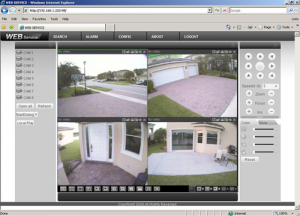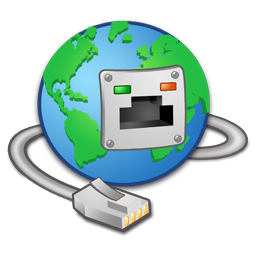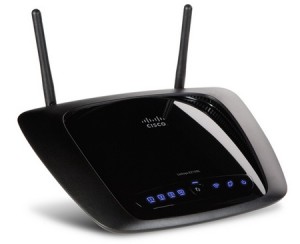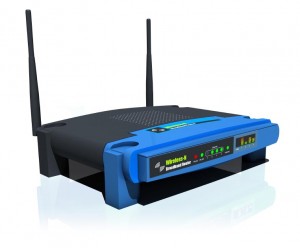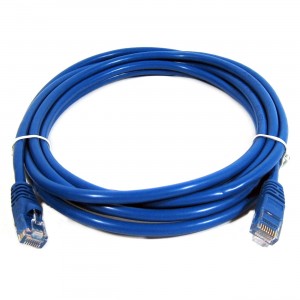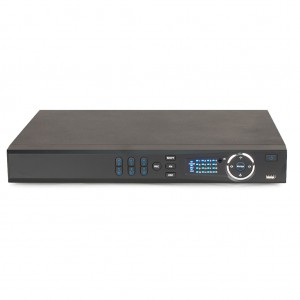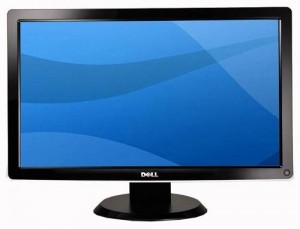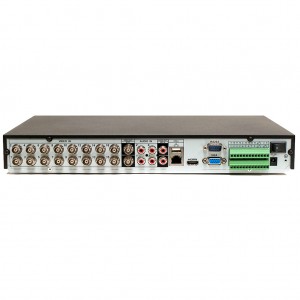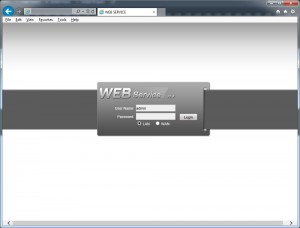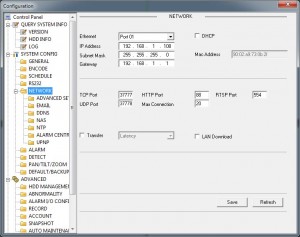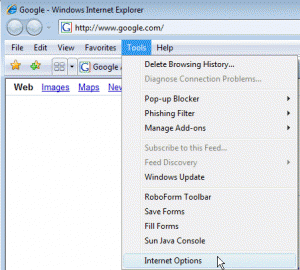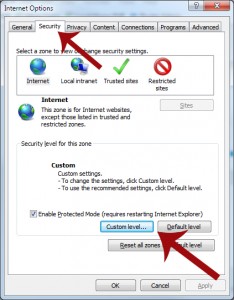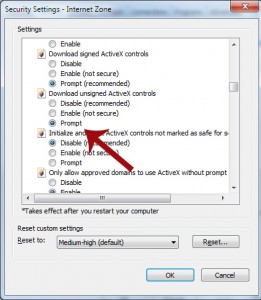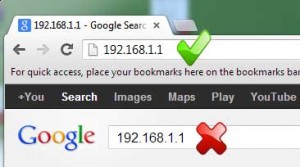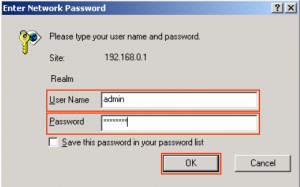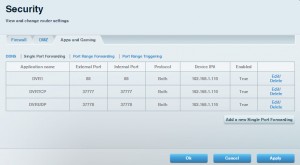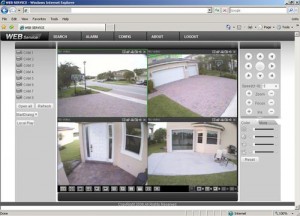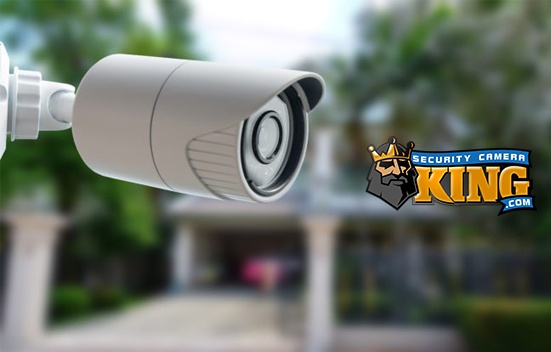One of the first things that people want to know about their surveillance system is whether or not they have the ability to connect it to the internet for remote viewing. In the past, security systems had to be monitored by a guard who was locked away in a room all day watching the monitors to make sure nothing would happen. The other option was to come back and review footage after something has occurred but then the damage may already be done. It’s extremely important nowadays to be able to view your security system remotely so that you can view it in real-time. Technology has progressed so much that you’re able to get notifications sent directly to your cell phone or tablet to let you know that your security cameras are capturing an event. This can likely save you the trouble of having to replace damaged or stolen property. By having the ability to view your Digital Video Recorder (DVR) over the internet, you will have a much better chance at stopping a crime from happening.
Not everyone is tech savvy. I have learned over the years that many of the things that may seem simple to those who use computers on a daily basis may be like trying to learn another language for most others without the extensive experience. Either way, by the end of this article I hope to show you how to connect your DVR to the internet from top to bottom so that you have a complete understanding of how to hook it all up, configure all of the settings as needed, and also understand why you need to set it up this way. Many tutorials online which show you how to connect your security system to the internet are very short and not detailed enough for you to have an understanding of what you’re actually doing.
First, here are some of the benefits of connecting your DVR to your network.
- Being able to watch your security cameras while you are away from the location is one of the most important features of current DVRs. This will give you the ability to prevent crimes as well as keep an eye on what is currently happening in the locations that the cameras are watching over.
- Being able to review and back up footage from your DVR remotely so that you have a copy of what is happening even if the DVR ends up getting damaged or stolen.
- Being able to configure the DVR and specialized cameras remotely. This is handy if you notice that the DVR needs to have some of its configurations modified.
- Being able to change settings on cameras that are all of a sudden not able to see due to conditions changing. Some people have had issues where their cameras looked great the whole first week that they had them set up but then all of a sudden a big storm comes in and they can’t see anything anymore and one of the camera’s may have a setting which can compensate for this condition change. If you’re not able to reach the location where the DVR and cameras are installed, this will allow you to change the settings from wherever you are so that you don’t miss out on anything in the meantime. However, please note that some cameras do not have these features, but for the ones that do, being able to access them remotely is a great feature to have.
There are a few basic things you will need in order to get started.
- Live Internet Connection. This can come from any internet service provider in your area. The faster the speeds they are able to provide you with, the better. However, it’s still possible to view your system remotely with a slower connection such as DSL. Usually the internet service provider will provide you with the option to rent a modem from them unless you have your own available for setup.
- Router. A Router is a device which forwards the data between your network connections. This will allow you to connect multiple devices to your single internet connection. Many homes today currently have Wi-Fi Routers that will allow you to connect your devices to your internet wirelessly. You will not need a wireless router to access your DVR remotely, so just about any router will do. Some of the larger router brands are Linksys (Cisco), D-Link, Netgear, Belkin, and even Apple.
Routers
- Ethernet Cables. These are usually sold as CAT5 (Category 5) cables which are used to connect you to the internet. Most DVR’s with the ability to be viewed remotely will come with a network port that you can attach your cat5 cable to. Sometimes the manufacturer will even include a cable with the system but unless you are planning on connecting your DVR near your router, most of the times the cable is too short. Be sure to measure out how many feet of cable you will need before purchasing your system. You will also need one Ethernet cable to connect the modem to the router. Routers usually come with their own short Ethernet cable as well.
- DVR with the ability to be remotely viewed. Not all DVRs have the ability to be viewed remotely. Some DVRs are just for recording and will not have the features that allow for you to connect to them through the internet. Make sure the DVR you have is capable of doing so by contacting the manufacturer or checking the manual that came with it.
- Monitor. For the initial setup, you will need some sort of monitor so that you can connect your DVR and view all of the settings you are configuring. Once these settings are configured, you will no longer need the monitor if you are only going to view the system remotely. Some DVRs have outputs that will also allow you to use a television as a monitor by connecting it using BNC, HDMI, VGA, or even composite RCA connections depending on the devices that you purchase.
Getting Started
- Make sure that your Modem is connected to the internet. Usually modems will have a series of lights on the front which are status lights to let you know that it’s currently working. All modems are different so many sure you get the information for yours from your service provider or its manual. Getting the model setup and connected is beyond the scope of this article and this step needs to be completed before moving forward.
- Connect your modem to the internet port on your router. Usually your router will have one port for the internet connection. This port is usually away from the other ports on the back of the router which are for the devices which will be connecting to the internet. Use a cat5 cable for this connection.
- Connect your DVR to one of the data ports of your router. Most routers come with at least 4 ports for hardware that will be connecting to the internet. You will also be using a cat5 cable for this connection. For the initial setup, you will not need the long cat5 cable if you are planning on relocating the DVR to a location that’s far away from the router. You may always move the DVR after the initial setup so the cable that came with your DVR should be fine.
- Connect your DVR to your monitor. This can be done using any of the methods available depending on the type of monitor you are using and DVR outputs available. If you have an HDMI or VGA port on both the DVR and Monitor, one of these are the preferable ones to be used.
Now that you have your hardware setup and connected, make sure everything is powered on and working. Next, check out the next step to configure your router and DVR and you will soon be able to view it remotely. I will be using a Techpro Security DVR which I purchased from SecurityCameraKing.com. All of their DVRs have the same interface when you log into them so configuring them will be pretty much the same. Other DVR’s may have menus that look a bit different but the settings are all generally the same. Same goes for the Router settings.
Configure your DVR
-
- Log into your DVR using the username and password provided by the manufacturer. If this DVR has already been previously configured, use the admin login information.
- Select the menu for Network Settings. In this section you will be able to assign an IP address to the DVR. This will be an internal static IP address. (This usually begins with 192.168.XXX.X). I would suggest using these settings to get started, you can always change them later.
- IP ADDRESS: 192.168.1.110 (This will be the ip address of the DVR)
- SUBNET MASK: 255.255.255.0 (Leave this unless your network has a modified subnet)
- GATEWAY: 192.168.1.1 (This will normally be the IP Address of your router)
- TCP PORT: 37777
- UDP PORT: 37778
- HTTP PORT: 88 (You can use port 80 but there are some Internet Service providers which block the use of port 80. I usually just change it to be on the safe side.)
- Configure Your Browser’s Security Settings In Order To Download the DVR Web Service. In order for you to connect to your DVR internally or externally within your network, you’re going to have to make sure that your browser is able to download the web service from the DVR. Just go to Tools > Internet Options > Security.
In this tab, you will see a button that says Custom Level.
Click it and make sure that the option for “Download Unsigned ActiveX controls” has “Prompt” (or Enable) selected instead of Disable.
This will make sure that when you access your DVR, the prompt will allow you to install the ActiveX web service that allows you to remotely access and configure your DVR. You can do the same for the other ActiveX settings as well. Once you are done, close Internet Explorer then restart it to make sure the settings have taken change.
- Connect to Your DVR Internally Using Internet Explorer. You should now be able to connect to your DVR internally within your network. This is a bit different from connecting to it externally. You will use the Static Internal IP Address and Port number that you configured on your DVR in order to do this. This will be ‘192.168.1.110:88’ as you have configured in the second step. The ‘:88’ at the end is the port that you’ll be using to connect to the web service of your DVR.
- Port Forward Your Router. The next thing you’re going to want to do is port forward your router. This is going to be necessary in order to connect to your DVR from a remote location. If you were to just type your external IP address into the browser, your router is not going to know which device you are trying to reach. There could be multiple computers and devices on that network so you need to tell the router which one to specifically connect to by assigning a sort of map to all of the ports you have configured.
- Log in to your router using the gateway IP address and username and password that has been set to it. By default, most routers have their default gateway IP address set to 192.168.1.1. This is what you will type into the URL bar of your browser. Once you put that in and hit Enter, a window should pop up asking you to log in. If you haven’t made any changes you should be able to put ‘admin’ into the username and ‘admin’ into the password field as well. Some Routers may have their password defaulted to ‘password’. You will have to check your router manual or with your network administrator to be sure. You can also search on Google to find out the defaults.
- Forward the Ports. Find the window or tab that is either called ‘port forwarding’ or ‘apps and gaming’. Go ahead and add a new port forwarding rule. The application name field is where you will put in anything you want that is descriptive to the device you’re port forwarding. In this case you can just put in “DVRWEB” to signify the DVR Web Service connection. External Port can be 88 (or whatever port you set it to on step 2), Internal Port is also set to 88, Protocol will be ‘both’ tcp/udp and the Device IP will be the IP of the DVR. In this case you will make sure it’s ‘192.168.1.110’. Make sure the rule is enabled by checking the box if there is one and save the rule. Then do the same for your TCP And UDP ports that were set on the DVR.You should have:
- DVRWEB – 88 – 88 – BOTH – 192.168.1.110 – Enabled
- DVRTCP – 37777 – 37777 – BOTH – 192.168.1.110 – Enabled
- DVRUDP – 37778 – 37778 – BOTH – 192.168.1.110 – Enabled
- Find out your External IP Address. Find the IP address of the network you’re currently setting up the DVR at by typing in “WHAT IS MY IP” into google. You will get your public IP Address and make sure to make a note of it. This is the address that you are going to use in order to connect to your DVR when you are in another location.
- Connect from the Outside. When you have the ability to connect from outside of the network you are in, type in your Public IP Address into the URL bar on Internet explorer and make sure to add the ‘:88’ at the end. You should see the ActiveX web service prompt. If you are able to connect to the DVR internally but are unable to once you are outside of that network, it will more than likely be a port forwarding issue. Check your settings and try again.


